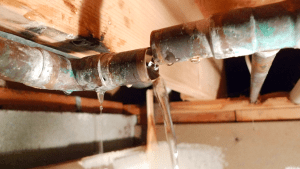What're your concepts on Detecting hidden plumbing leaks?

Early detection of dripping water lines can mitigate a prospective calamity. Some tiny water leaks may not be visible.
1. Analyze the Water Meter
Every home has a water meter. Examining it is a guaranteed way that assists you discover leaks. For beginners, switch off all the water resources. Guarantee no person will flush, make use of the faucet, shower, run the washing machine or dishwasher. From there, most likely to the meter as well as watch if it will certainly alter. Because no person is utilizing it, there must be no movements. That suggests a fast-moving leakage if it moves. Furthermore, if you find no changes, wait an hour or more as well as inspect back once more. This indicates you might have a slow leak that might also be below ground.
2. Inspect Water Intake
If you identify abrupt modifications, regardless of your consumption being the exact same, it implies that you have leakages in your plumbing system. A sudden spike in your expense shows a fast-moving leakage.
A stable boost every month, also with the exact same routines, reveals you have a sluggish leakage that's likewise slowly rising. Call a plumber to completely check your residential property, particularly if you feel a cozy location on your floor with piping underneath.
3. Do a Food Coloring Examination
30% comes from bathrooms when it comes to water consumption. Examination to see if they are running correctly. Drop flecks of food color in the container and wait 10 minutes. If the shade somehow infiltrates your dish during that time without flushing, there's a leakage between the storage tank and bowl.
4. Asses Exterior Lines
Don't forget to check your outdoor water lines too. Should water permeate out of the link, you have a loosened rubber gasket. One small leak can waste tons of water and also increase your water expense.
5. Examine and Assess the Scenario
Property owners should make it a routine to check under the sink counters and also inside cabinets for any kind of bad odor or mold development. These two warnings show a leak so punctual attention is called for. Doing routine assessments, even bi-annually, can conserve you from a significant problem.
A lot more importantly, if you understand your house is currently old, keep a watchful eye on your heating units, pipes, pipes and so on. Look for discolorations and compromising as the majority of pipelines and also home appliances have a life expectancy. They will certainly likewise naturally wear away as a result of deterioration. Don't wait for it to rise if you think dripping water lines in your plumbing system. Call an expert plumber immediately so you do not end up with a horrible mess in your house.
Early detection of dripping water lines can alleviate a potential calamity. Some small water leakages might not be visible. Examining it is a guaranteed means that helps you discover leakages. One little leakage can waste heaps of water and also increase your water costs.
If you believe dripping water lines in your plumbing system, do not wait for it to rise.
WARNING SIGNS OF WATER LEAKAGE BEHIND THE WALL
PERSISTENT MUSTY ODORS
As water slowly drips from a leaky pipe inside the wall, flooring and sheetrock stay damp and develop an odor similar to wet cardboard. It generates a musty smell that can help you find hidden leaks.
MOLD IN UNUSUAL AREAS
Mold usually grows in wet areas like kitchens, baths and laundry rooms. If you spot the stuff on walls or baseboards in other rooms of the house, it’s a good indicator of undetected water leaks.
STAINS THAT GROW
When mold thrives around a leaky pipe, it sometimes takes hold on the inside surface of the affected wall. A growing stain on otherwise clean sheetrock is often your sign of a hidden plumbing problem.
PEELING OR BUBBLING WALLPAPER / PAINT
This clue is easy to miss in rooms that don’t get much use. When you see wallpaper separating along seams or paint bubbling or flaking off the wall, blame sheetrock that stays wet because of an undetected leak.
BUCKLED CEILINGS AND STAINED FLOORS
If ceilings or floors in bathrooms, kitchens or laundry areas develop structural problems, don’t rule out constant damp inside the walls. Wet sheetrock can affect adjacent framing, flooring and ceilings.
https://www.servicemasterbyzaba.com/blog/how-to-detect-water-leakage-in-walls/

I have been very eager about Finding hidden leaks and I really hope you liked our blog entry. Enjoyed reading our blog entry? Please share it. Let someone else find it. We love reading our article about Leaking water lines.